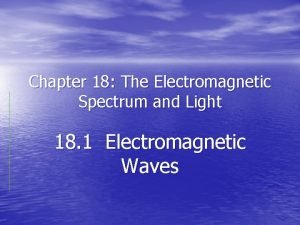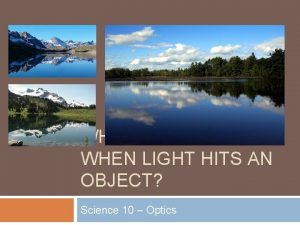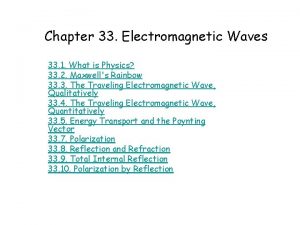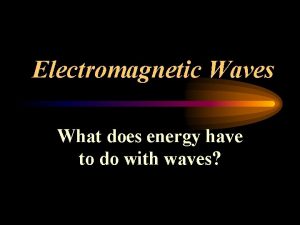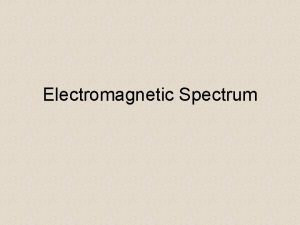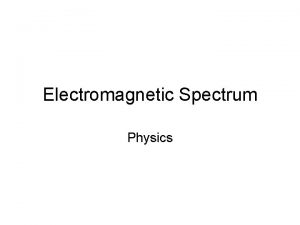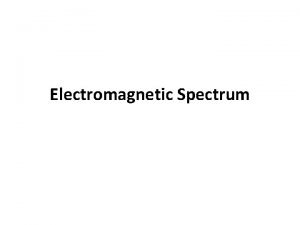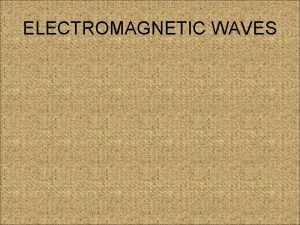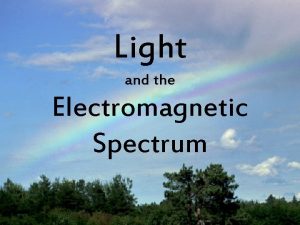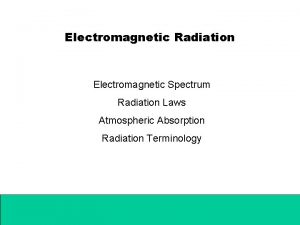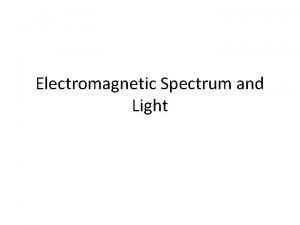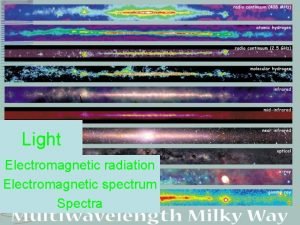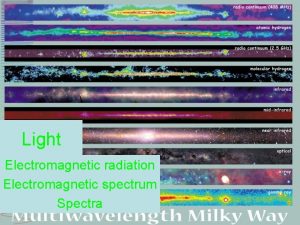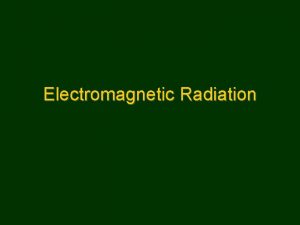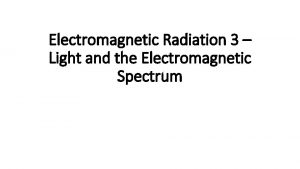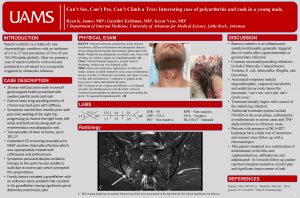Electromagnetic Spectrum Light you cant see Electromagnetic radiation

















- Slides: 17

Electromagnetic Spectrum Light you can’t see

Electromagnetic radiation is energy that can travel through space in the form of waves.

Increasing Energy

You actually know more about it than you may think! The electromagnetic spectrum is just a name that scientists give a bunch of types of radiation when they want to talk about them as a group. Radiation is energy that travels and spreads out as it goes– visible light that comes from a lamp in your house and radio waves that come from a radio station are two types of electromagnetic radiation. Types of EM radiation are: 1. Radio Waves 5. Ultra violet 2. Microwave 6. X-rays 3. Infrared 7. Gamma rays 4. Visible Light

• Radio waves: This is the same kind of energy that radio stations emit into the air for you to capture and turn into your favorite Mozart, Madonna, or The Fray tunes. • But radio waves are also emitted by other things. . . such as stars and gases in space.

Microwaves: They will cook your popcorn in just a few minutes! Microwaves in space are used by astronomers to learn about the structure of nearby galaxies, and our own Milky Way!

• Infrared Rays: Our skin emits infrared light (heat), which is why we can be seen in the dark by someone using night vision goggles. • In space, IR light maps the dust between stars.

• Visible light: This is the part that our eyes see. Visible radiation is emitted by everything from fireflies to light bulbs to stars. . . also by fast -moving particles hitting other particles.


• Ultraviolet: We know that the Sun is a source of ultraviolet (or UV) radiation, because it is the UV rays that cause our skin to burn! • Stars and other "hot" objects in space emit UV radiation

• X-Rays: Your doctor uses them to look at your bones and your dentist to look at your teeth. • Hot gases in the Universe also emit Xrays.

• Gamma Rays: Radioactive materials (some natural and others made by man in things like nuclear power plants) can emit gamma-rays. . • But the biggest gammaray generator of all is the Universe! It makes gamma radiation in all kinds of ways.

Telescopes • There are different kinds of telescopes that use different wavelengths of electromagnetic energy to study the universe.

Four Views of the Crab Nebula • Different type of telescopes collect electromagnetic radiation at different wavelengths. Astronomers are able to learn a great deal about the Crab Nebula by examining these different images. The images are shown at different scales.

Visible Light Regular visible light is really a combination of several colors. Red Orange Yellow Green Blue Indigo Violet Different gases, when ionized, will give off different color bands of light.

Star Spectrums Astronomers can use line spectrums to identify the chemical elements in a star. Each element produces a characteristic pattern of spectral lines.

Measuring with Light • When stars are moving toward Earth, their wavelengths appear to be shortened or shift toward the blue side of the spectrum • When stars are moving away from Earth, their wavelengths appear to be lengthened or shift toward the red side of the spectrum • Site
 You can't improve what you don't measure quote
You can't improve what you don't measure quote You can t manage what you don t measure
You can t manage what you don t measure Types of radiation in the electromagnetic spectrum
Types of radiation in the electromagnetic spectrum Spectrum of waves
Spectrum of waves Sound waves are transverse waves true or false
Sound waves are transverse waves true or false Chapter 18 the electromagnetic spectrum and light
Chapter 18 the electromagnetic spectrum and light Why cant we see atoms
Why cant we see atoms Why we cant see air
Why we cant see air If you cannot measure it you cannot manage it
If you cannot measure it you cannot manage it You cant manage what you dont measure
You cant manage what you dont measure Light light light chapter 23
Light light light chapter 23 Light light light chapter 22
Light light light chapter 22 Chapter 22
Chapter 22 What happens when light hits an opaque object
What happens when light hits an opaque object Chapter
Chapter Absorption spectrum
Absorption spectrum Formula for intensity of electromagnetic wave
Formula for intensity of electromagnetic wave Facts about electromagnetic radiation
Facts about electromagnetic radiation





